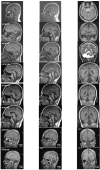Uner tan syndrome: history, clinical evaluations, genetics, and the dynamics of human quadrupedalism
- PMID: 21258577
- PMCID: PMC3024602
- DOI: 10.2174/1874205X01004010078
Uner tan syndrome: history, clinical evaluations, genetics, and the dynamics of human quadrupedalism
Abstract
This review includes for the first time a dynamical systems analysis of human quadrupedalism in Uner Tan syndrome, which is characterized by habitual quadrupedalism, impaired intelligence, and rudimentary speech. The first family was discovered in a small village near Iskenderun, and families were later found in Adana and two other small villages near Gaziantep and Canakkale. In all the affected individuals dynamic balance was impaired during upright walking, and they habitually preferred walking on all four extremities. MRI scans showed inferior cerebellovermian hypoplasia with slightly simplified cerebral gyri in three of the families, but appeared normal in the fourth. PET scans showed a decreased glucose metabolic activity in the cerebellum, vermis and, to a lesser extent the cerebral cortex, except for one patient, whose MRI scan also appeared to be normal. All four families had consanguineous marriages in their pedigrees, suggesting autosomal recessive transmission. The syndrome was genetically heterogeneous. Since the initial discoveries more cases have been found, and these exhibit facultative quadrupedal locomotion, and in one case, late childhood onset. It has been suggested that the human quadrupedalism may, at least, be a phenotypic example of reverse evolution. From the viewpoint of dynamic systems theory, it was concluded there may not be a single factor that predetermines human quadrupedalism in Uner Tan syndrome, but that it may involve self-organization, brain plasticity, and rewiring, from the many decentralized and local interactions among neuronal, genetic, and environmental subsystems.
Keywords: MRI; PET; Uner Tan syndrome; balance; cerebellum; facultative quadrupedal locomotion; human quadrupedalism; human.; intelligence; locomotion; self-organization; speech; systems theory.
Figures




References
-
- Tan U. Unertan sendromu ve insan ruhunun evrimine iliskin yeni bir teori. Biyobank. 2005;3(15)
-
- Tan U. Unertan syndrome; quadrupedality, primitive language, and severe mental retardation; a new theory on the evolution of human mind. NeuroQuantology. 2005;4:250–255.
-
- Tan U. A new syndrome with quadrupedal gait, primitive speech, and severe mental retardation as a live model for human evolution. Int J Neurosci. 2006;116:361–9. - PubMed
-
- Smith LB, Thelen E. Development as a dynamic system. Trends Cogn Sci. 2003;7:343–8. - PubMed
-
- Tan U. Discovery of Unertan syndrome and reverse evolution: as an “Aha!” experience. NeuroQuantology. 2008;6:80–3.
LinkOut - more resources
Full Text Sources
